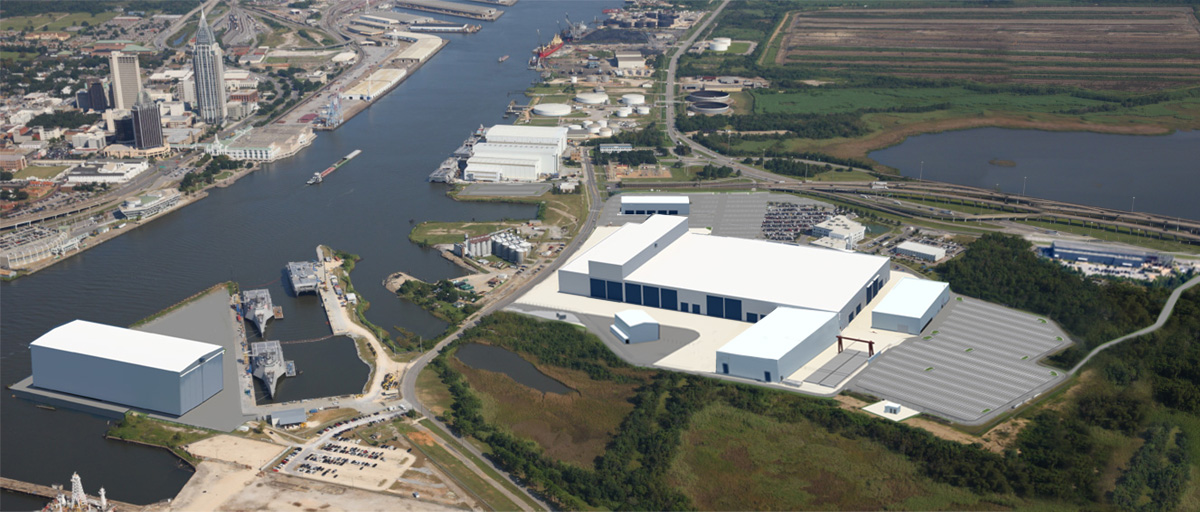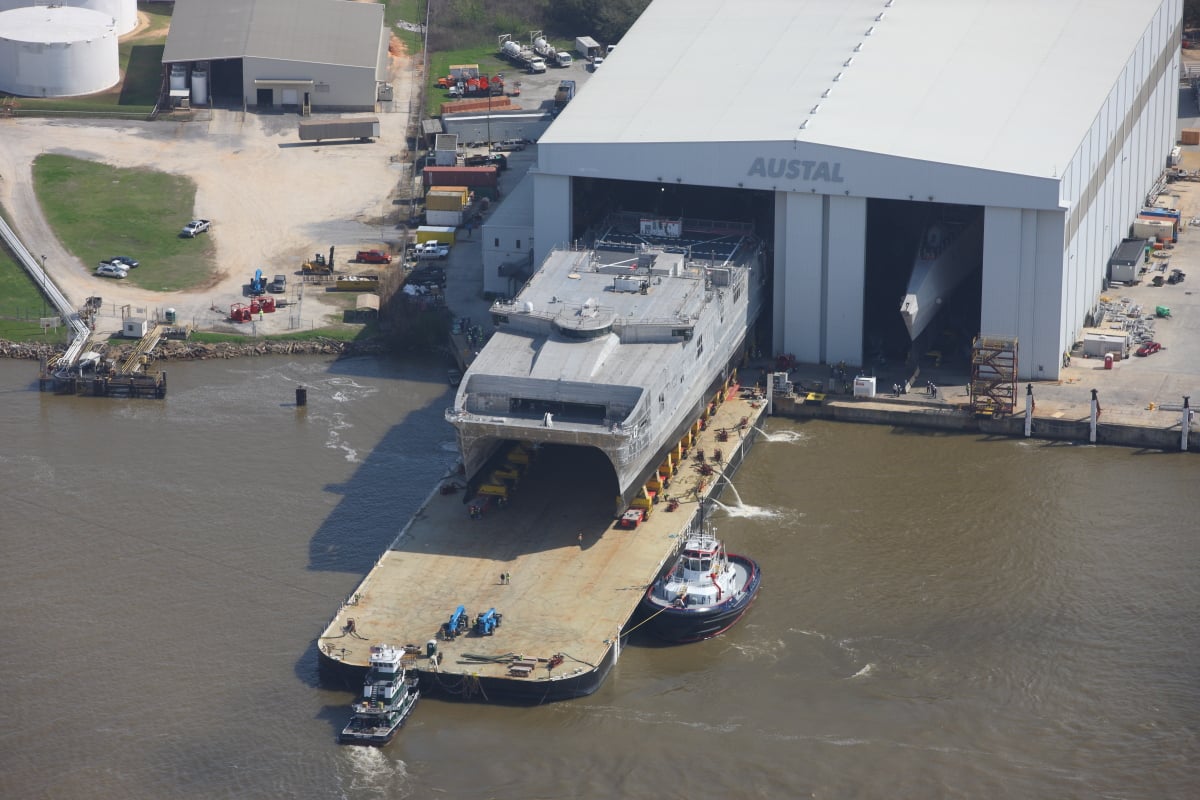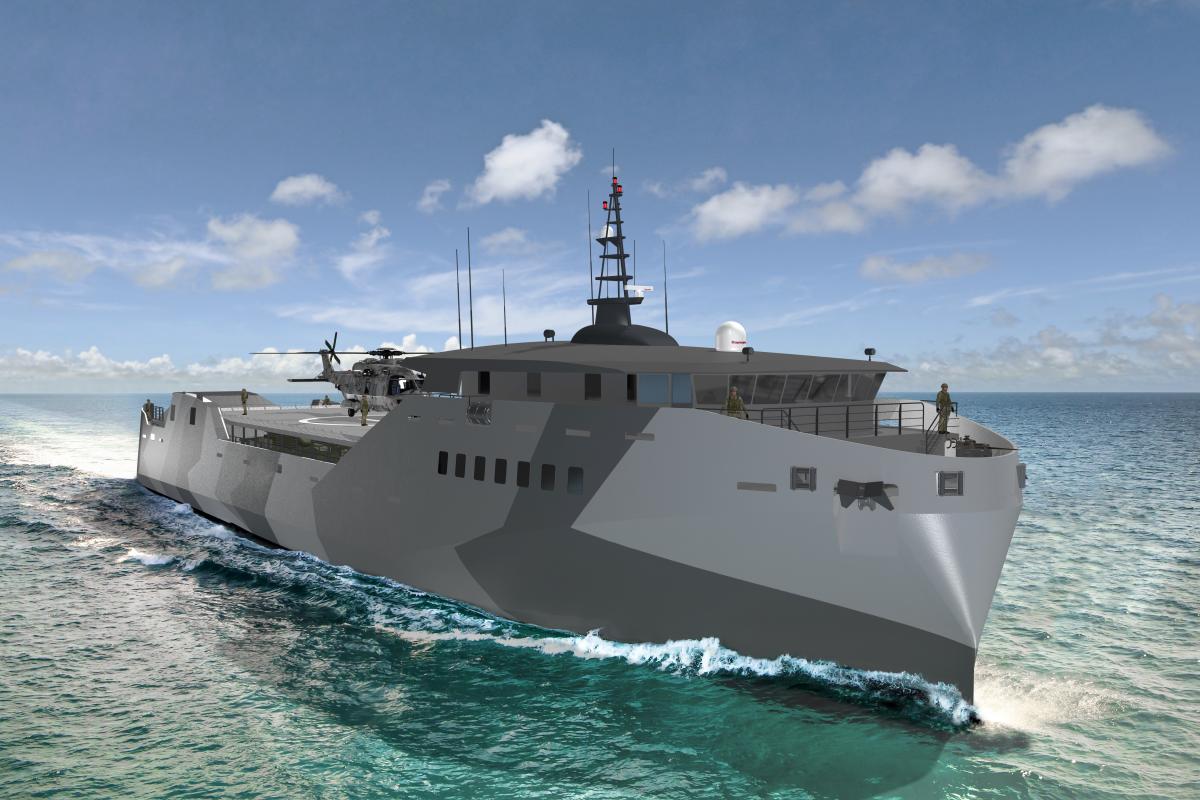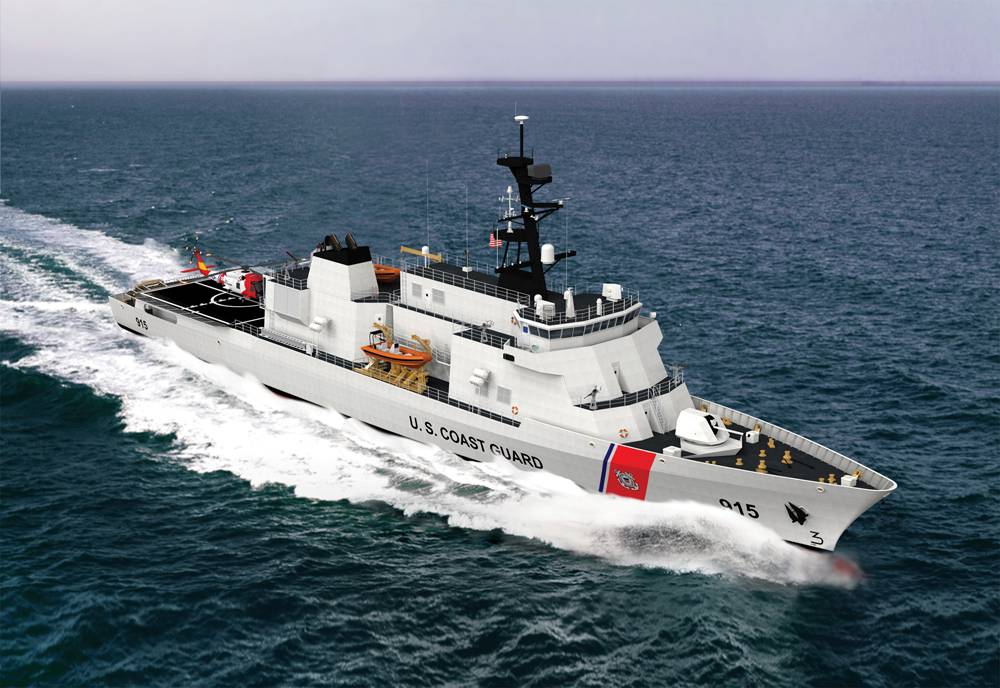
The Austal USA shipyard in Alabama that specializes in aluminum ship construction is officially on its way to also offering steel ships, breaking ground on a new facility on Friday meant to open up new business opportunities with the Navy and Coast Guard in the short term.
By April 2022, the yard will be transformed to have separate production lines and facilities for aluminum ships and steel ships – the former continuing to build Spearhead-class expeditionary fast transport ships (EPFs), the company hopes, and the latter building the Offshore Patrol Cutter, the Light Amphibious Warship or eventually the Constellation-class frigate, Larry Ryder, the company’s new vice president of business development and external affairs, told USNI News on Friday.
“We’ve been a great builder of aluminum ships; we want to become the Navy’s premier builder of these mid-sized steel ships going forward,” Ryder said.
The company’s module manufacturing facility will be split in half, with a wall dividing the steel side and aluminum side to keep components and tools in their proper areas. The yard will also build a paint and blast facility and a panel line – but despite working with a new material, Ryder said the company’s manufacturing processes, employee training and other qualities will carry through to the new business line.
“We just want to continue to build ships for the Navy, and whatever the requirements are – if they want aluminum ships, they want steel ships – we’re going to be able to do both down here at the yard in Mobile. I think we’re making a pretty significant investment in the company and in expanding our capabilities going forward, and that’s our intent. We’ve continued to grow throughout our history, and this is just the latest step in that evolution of our capabilities,” Ryder said.

roll-out on Feb. 28, 2018, at the Austal USA yard in Mobile, Ala. Austal photo
Austal USA received $50 million last year as part of the COVID-19 pandemic economic recovery measure, in an effort to stimulate the local economy with jobs at the yard and in the construction companies that will be building the new facilities. Austal USA matched that investment, for a total of $100 million going towards bringing another steel shipbuilding capability to the Gulf Coast. Ryder said some employees will be trained to work on steel ships, and some new personnel will be hired to bring new skillsets to the yard to support the new work.
“Our focus in the near term is on the Navy’s light amphibious warship program, LAW, and the Coast Gard’s offshore patrol cutter, OPC. We think both of those programs are really in the sweet spot of the size of ship that our yard is optimized for,” Ryder said of the kind of work they hope to tackle first.
“So we’re driving hard to have this project complete and to be competing for those two programs. And down the road, as you’re well aware, we weren’t successful in our bid for the frigate, but our plan is to be the Navy’s follow yard when they compete that program for the frigate design. So we’ll be ready to build the Fincantieri steel monohull frigate down here in the next few years when the Navy goes forward with that plan.”
Ryder said those three ships represent not just the size ship Austal USA is optimized for, but the complexity in terms of the modules that would be built.
“Whereas the DDG is a little too big for us, the frigate and the OPC and the LAW fall into the footprint of what we can handle down here and what we’re best at producing,” he said.
The OPC is being competed now. The LAW program has six companies working with Naval Sea Systems Command on initial design concepts, with the Navy and Marine Corps hoping to compete the program next year and buy the first vessel in late FY 2022, USNI News has previously reported.

For Austal, it would be important for the yard to win one of those programs to avoid any disruptions to the workforce. The yard currently builds EPFs and Littoral Combat Ships for the Navy –the Navy has ended LCS acquisition and moved on to the frigate in Fiscal Year 2020, but Austal still has four LCSs in various phases of construction and two final ships on contract before the production line ends.
On the EPF side, the yard was supposed to get funding for EPF-15 in the FY 2020 budget, but that ship was taken out of the budget. It was included in FY 2021, so “that’s helped stabilize us. We’re looking forward – the 30-year plan included six EPFs, two in FY ‘22, so we’re expecting to see that in the budget. So the award of those two EPFs would really help stabilize the workforce and production of the aluminum ships and serve as a bridge as we complete the steel capital investment and compete for those programs. So, we’re going to have a little bit of a valley here that we’re trying to stabilize, and then we’ll start growing with the award of some steel ships.”
“The timeline of being done next April – and the whole schedule’s built around that – is focused on the fact that the Coast Guard’s offshore patrol program is in competition now. We are bidding on that, and I think this investment we’re making is intended to show the Coast Guard that we’re serious. It’s over $100 million in investment being made to be a steel shipbuilder, premiere steel shipbuilder, so that’s the Coast Guard. And same with the Navy, that light amphibius warship program is moving along – it’ll come in behind timeline-wise, it’s a little after the OPC – so we’ll be ready.”
On the aluminum ship side, the company is eyeing several opportunities to leverage the EPF program going forward – including using it as the entry point to building medical-focused ships and autonomous ships.
The EPF program started out as a 10-ship program and has continued to grow as the fleet finds more and more uses for it – moving people and logistics around locally, in line with its original intra-theater lift mission, as well as serving as an LCS tender in U.S. 4th Fleet and a command ship in U.S. 7th Fleet.
Beginning with EPF-14, Austal is moving to a Flight II EPF design with an enhanced medical capability that includes a medical ward with resuscitative care capability and a limited Intensive Care Unit (ICU) capability. This design change is not meant to dictate what role the ship would play or take away from other missions – it wouldn’t have to just work as an ambulance ship; it would still have the same ability to be an LCS tender, for example – but it could be leveraged by fleet commanders if there were casualties after combat or a natural disaster.

Still, the focus on medical services and the Navy’s need for distributed medical capability around the globe has led Austal to pitch a new hospital ship design to the service. It would be a catamaran designed from the keel up to have all the capability of the aging USNS Mercy (T-AH-19) and USNS Comfort (T-AH-20), with somewhat less capacity – but it would be easier to operate and maintain and could sail much faster, Ryder said. As the Navy looks at a more distributed footprint across the globe in the future, with smaller groups of sailors and Marines scattered among islands or in small ship formations, Austal is hoping to continue its talks with the Navy about what this hospital ship design could bring to the force.
What’s certain to be included in the future fleet is unmanned surface vessels. Ryder said the EPF was built with significant hull, mechanical and electrical (HM&E) autonomy to allow for a smaller crew and would therefore be a good starting point for a Large USV design. He said it could accommodate any of the missions the Navy has kicked around for LUSV, including unmanned logistics delivery or even offensive strike if the design was modified to include vertical launching system cells.
Congress added funding in FY 2021 to turn an EPF already in the production line into an LUSV prototype for fleet testing. Ryder said Austal is working with the Navy now to accomplish that and get the vessel to the fleet for experimentation with a craft that would be much larger than the Sea Hunter Medium USV that the fleet has the most familiarity with.
Though Ryder said EPF makes for a great testbed for LUSV experimentation, “our focus is designing the ships from the keel up to be unmanned or optionally manned, however the Navy defines its requirements, and optimizing what we know best, which is the hull, the HM&E portion of that, the HM&E controls, and plugging that into the … the autonomy mission software, navigation software provided by others.”





